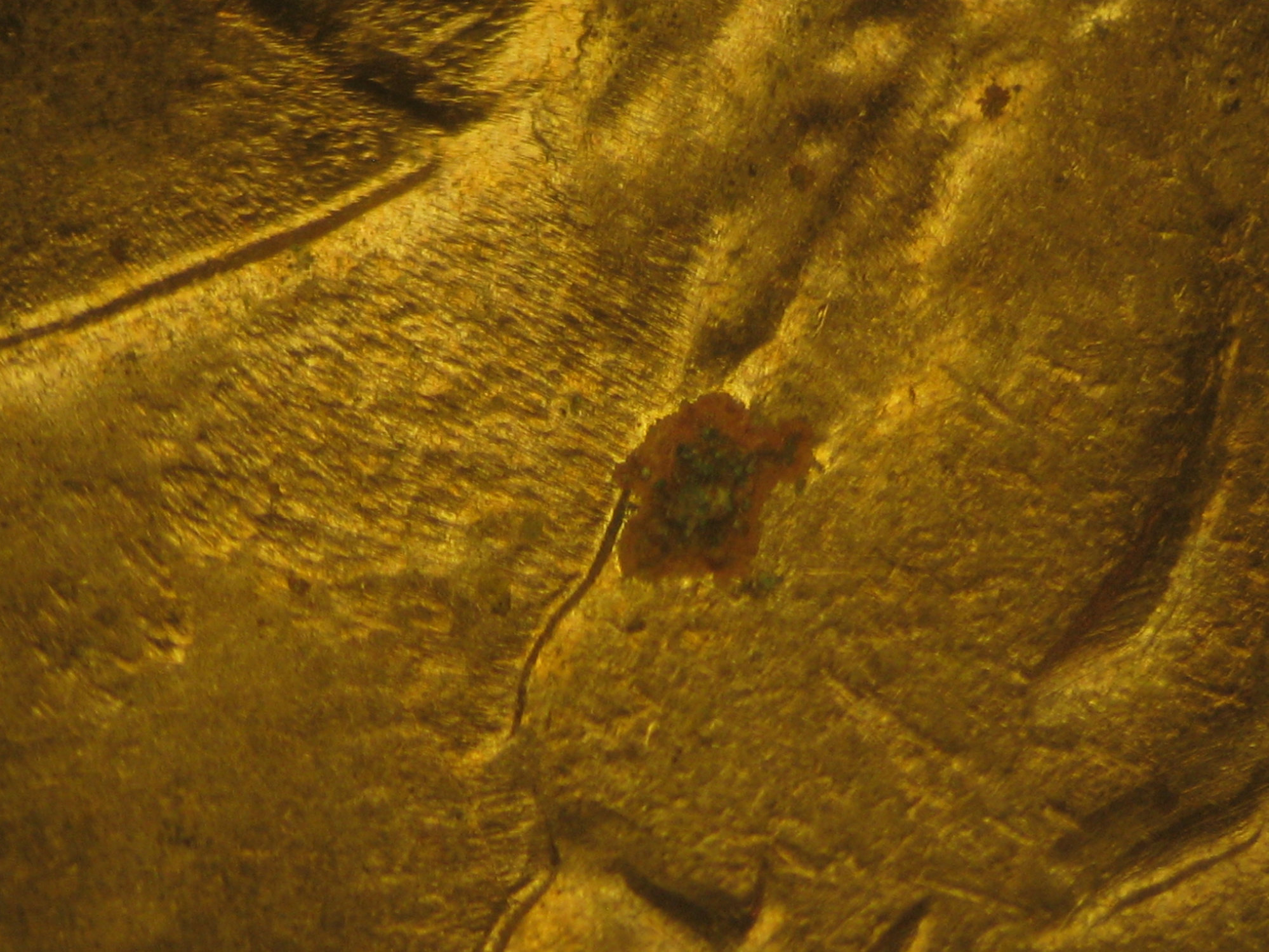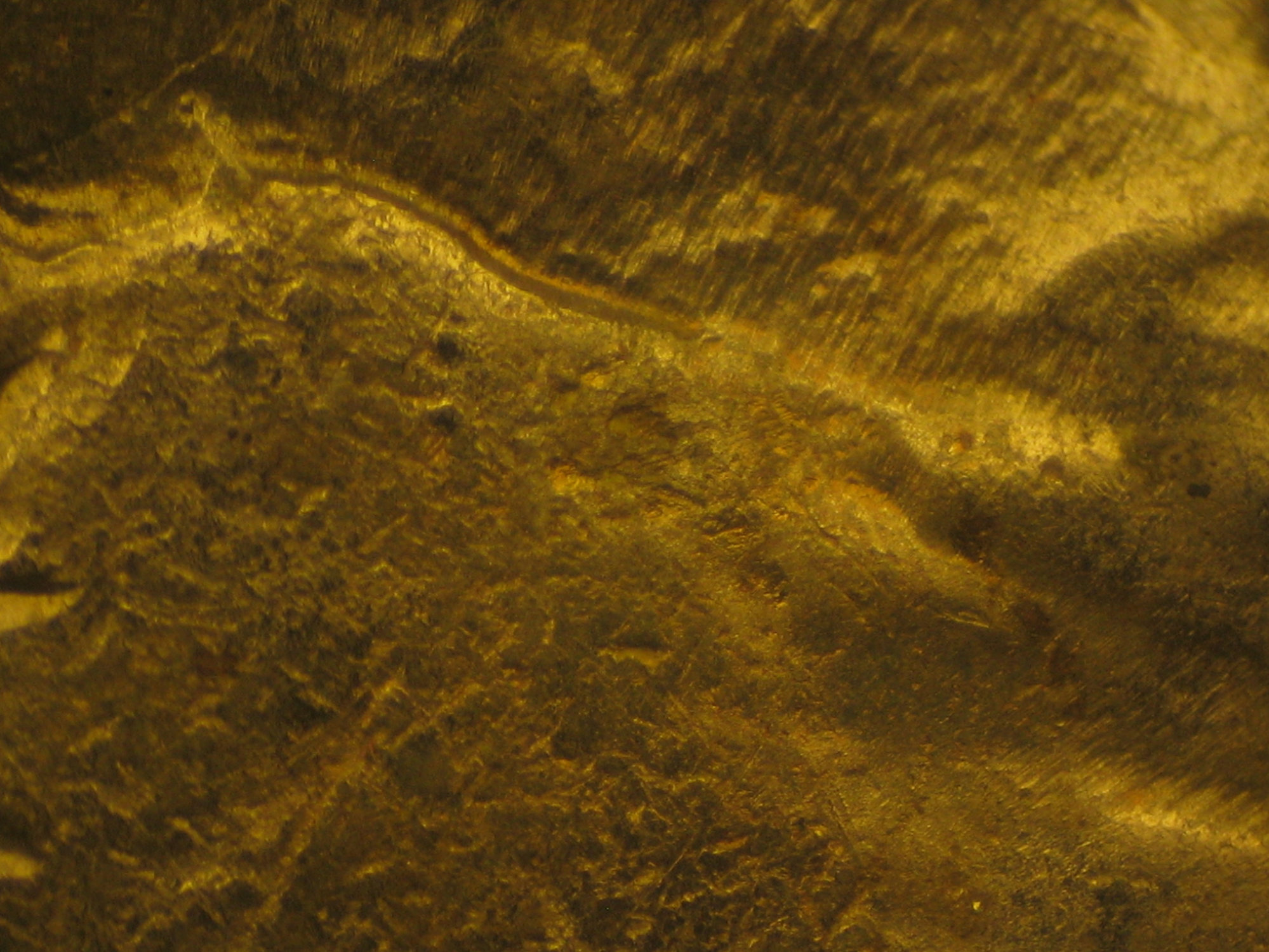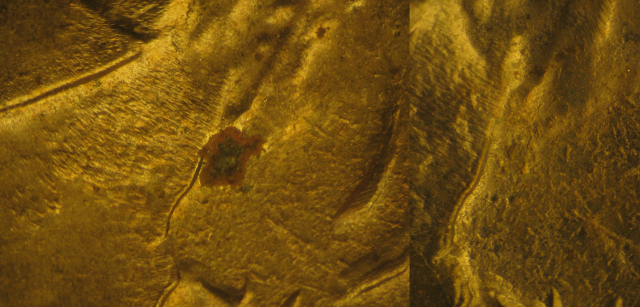Why use a TPGS conservation offered by our host rather a "DIY job?"
 Insider2
Posts: 14,452 ✭✭✭✭✭
Insider2
Posts: 14,452 ✭✭✭✭✭
Pictures worth a thousand words.
BEFORE: Corrosion spot on an otherwise "gem" Buffalo nickel.

AFTER: Microscopic spot conservation leaving the coin's beautiful "skin" unaffected.

Unfortunately I forgot to color correct image and take it with the coin in the same orientation. The "after" image is using more magnification too ![]() So What! That's not the point of the post.
So What! That's not the point of the post. ![]()
4
Comments
Kind of like doing plumbing. "Hey, it's only water! Anyone can do plumbing!"
Until your DIY job leaks and ruins your floor, walls, and ceiling.
I'd rather let someone who KNOWS what they are doing, what is possible, and what isn't, and be reasonably sure it is done right the first time. (The second time is probably too late!)
Besides....the one time I sent in a coin for PCGS restoration, it upgraded from AU-55 to MS-62. It was a MIRACLE!!
Whenever I have a problem, I always believe in going to a professional doctor and not the want-to-be at the local bourse.

Amazing.
I wasn't so fortunate my one and only time using the service ATS, 10+ years ago.
Hopefully they've evolved.
I debated long and hard over having a local dealer assure me he could remove black spots on a Canadian 1899 50c. It was an xf45. I sent it to TPG for conservation and encapsulation. It came back an AU58. Several thousands of $ mor valuable. Taught me a lesson for sure.
Bob Sr CEO Fieldtechs
For something like you posted or black spots using a professional TPG company for conservation would be the only safe way to go in my opinion, especially on a coin worth more than $100 or so. On the other hand I might try my luck with acetone for removing PVC.
it's crackers to slip a rozzer the dropsy in snide
Had great luck myself with a shield nickel. Removed a reverse black spot, went from 64 to 65. Money was not the main object, just couldn't look at the coin. No way I could have done it, would probably have ruined the coin.
Post the after picture 1st next time and let us ponder it - all I can see is the missing design element and loss of flow lines in the 2nd picture.
I tried flipping things so I could understand better - fixed on right. Are you sure these are same coin?

Depends on the coin and the problem it has. If I know what to do, why not.
I just used it for the first time-a 1921 Peace dollar. It's not back yet. I sent it to guarantee the grade and maybe get an upgrade.
Agree with this. If it's an expensive classic proof with a spot, let the professions fix it. If it's an ASE with a finger print, dip it yourself.
Worry is the interest you pay on a debt you may not owe.
"Paper money eventually returns to its intrinsic value---zero."----Voltaire
"Everything you say should be true, but not everything true should be said."----Voltaire
Just curious Insider, as a conservation pro would you have been as successful, or would you need access to chemicals and tech that you don't have?
For major issues, I would go to the TPG conservation service... Minor crud removal, I will do it myself. Cheers, RickO
Did this one myself. You just never know how a coin will look once the lacquer is removed.
Mike Printz image:
I remember when NCS used to send out conservation of the month emails with coins they where proud of conserving. On some yes the spot was gone but the overall surfaces looked horrifically stripped. As for every successful speedy professional conservation there's plenty of coins that are ruined... Maybe not at first, but they turn in the holder over time.
Yes, Unfortunately I raised the magnification for the "after" image and posted it upside down.
Check out the horizontal crease in the braid at the right. In the "after" you'll see the crease and if you follow it over you'll see the tiny crater where the corrosion "ate away" the surface.
So if they conserved and removed the schmutz, there had been no reaction with the metal, ie it wasn't below the surface? Aren't you competent to do the same thing, Insider?
Look at the OP. The coin had a "serious" reaction to something that caused a corrosion spot. When a coin's surface is corroded or has reached "end-stage" BLACK oxidation, the underlying surface is destroyed. Nothing can restore it. However, on occasion, the damage can be made less noticeable.
Reasons I have had was that NGC would refuse to even attempt a conservation; the long waits, the expense. So if you are kept waiting some weeks or a month and they don't do the job or maybe do it badly, obviously the regret factor is high. Sometimes if you want a job done right you need to do it yourself or find someone such as yourself who can do it quickly and reasonably. But you don't have the specialized chemicals that NCS and PCGS have apparently, not sure what they are but would like to know all about your methods.
I have conserved a few coins with NGC, I could not be more pleased. Takes for ever, sure, but the results are superb.
Best thing is after conservation the TPGS may raise the original grade.
How is this not considered coin doctoring?
That's why you dump them quickly.
Some coin doctoring is good. Removing PVC from a coin to save the coin from further damage is like removing cancer from a person to save that person.
Worry is the interest you pay on a debt you may not owe.
"Paper money eventually returns to its intrinsic value---zero."----Voltaire
"Everything you say should be true, but not everything true should be said."----Voltaire
ANYTHING you do to a coin that changes its appearance or condition can be considered coin doctoring by nit-picking purists. Some call it conservation.
Coin doctoring (as with many things) occurs in degrees. There is also the intent and the outcome/result involved. Thus there is good "coin doctoring" and failed "coin doctoring." The best "coin doctoring" cannot be detected very easily and will be unnoticed by at least 98% of the examiners.
"Coin doctoring" makes the world go around. I am a very proud "coin doctor." Most dealers I have gotten to know are "coin doctors." I would bet that many reading this, including you, are also "coin doctors" by a strict interpretation.
Most dealers I have gotten to know are "coin doctors." I would bet that many reading this, including you, are also "coin doctors" by a strict interpretation.  Get over it.
Get over it. 
As with most things. experience and training count. Therefore some folks are better than others. Additionally, If a conservation specialist (not the average coin dipper at the service) tells you he/she has never ruined a coin either by accident (wrong chemical or method) or by "complete surprise" (everything is done correctly that had been done thousands of times before) they are a liar!
I certainly understand that some forms of conservation (like an acetone wash or light dip) were considered market acceptable, but spot removal seems to always carry a negative connotation from the threads I have seen where the topic is discussed. For what it is worth, I have no problems with what was done with the coin. I think I have even PMed you for advice on a proof copper piece of mine that need some... help with spots so there is no negativity directed towards you.
If a damaged coin can be saved from the scrap pile it's repair is perfectly acceptable. They're not going to mint any more of them and you already own the one in hand. If it can be corrected, I'm fine with that.
Now the clowns on E-Bay selling "rainbow toned" coins that were white last week, they're really the scourge of the hobby.
NONE TAKEN. Most folks in the business or long-time collectors "play" with their coins in some fashion.
Most folks in the business or long-time collectors "play" with their coins in some fashion.
Get to a show early and watch the copper dealers buff their coins when they set them out in the case. BTW, When a spot is removed from a coin and no one can tell... Be thankful that much of the business at a conservation service is taking copper spots off gold coins!
I cannot stand to see any form of debris on a coin and regularly call folks for permission to remove it!
Speaking of copper spots on gold coins, I agree and have been bite by it. On a 27 saint. Gave it a look it was a 63 in a common date that looked fine . Took it out of my SdB a year latter and dang where that spot come from😤 Someone had doctored the coin then had it graded and sold it. I was pissed it was like milk spots to me.
On pocket watches if a gold filled case has a small line of brass they polish it and throw it on EBay before it changes colors again, now that crooked but there are tricks one must be aware of in any hobby.
Yea I found his secret mark!💩
Dip it and flip it.
I don't know, the whole process seems off to me. Most of the time they just strip the entire coin and you are stuck with what they send back. For a nickle that isn't so bad but silver most of the time looks worse and is often freshly reactive again and often changes again over the next couple of years.
Back before the TPGs watered down/eliminated their warranty, I sent some coins in with PVC and natural skin, I begged just for acetone but got back completely white/grey XF/AU coins that had to blown out at auction (still better than what happens now when you have bad coins in TPG holders).
Collectors need to be realistic about what is possible and realize they don't spend very long on most coins. From an ROI perspective you either have to be very selective about what needs to be done vs upside or 98.9% of the time just blow the coins out at auction as-is and us the money to buy coins that don't need futzing with.
Also the methodology of getting problem coins in non-problem holders off the market and taking care of collectors being a brand value protection seems to have gone the way of the Dodo replaced with a paper promise that is heaped in technicalities that leaves lots of problems in problem free holders as to protect the bottom line more so than collectors. Just my 2c
11.5$ Southern Dollars, The little “Big Easy” set
Most proper conservation takes time. It should be this way. Unfortunately, proper conservation is a money looser!
In the time it took to remove that spot (10+ min?) we lost money. Say we charged $30, how many coins can a professional grade in 10 minutes? Still a losing proposition. We are all lucky the TPGS don't charge a conservation fee more in line with the work.
Dipping the coin properly (one minute) would result in an easy profit but the result would not have been the same. The skin would have been stripped away.
I spent $1000.00 to have a coin conserved
it came back looking the same as it was.
NO improvement at all.
Just a loss!
I had a fairly dark '21 Peace in an NGC MS64 holder I bought. Super strike and luster. I cracked it and lightened it. First time through PCGS it crossed as a 64. The second time it came back 65. Now it has a green CAC sticker on it. If you are careful, you can DIY.
I have more wins than losses, but my biggest loss was a 1937 proof Buffalo Nickel. It had some odd coloring, and I have found a quick dip that is diluted works well. Unfortunately, the dip I used had been used before on silver coins. Nickel and copper are the metals they use as a base to plate with, so it had a beautiful silver-plating. Gave it a nice pretty chrome blue color. That was a head slap and a "duh" for me.